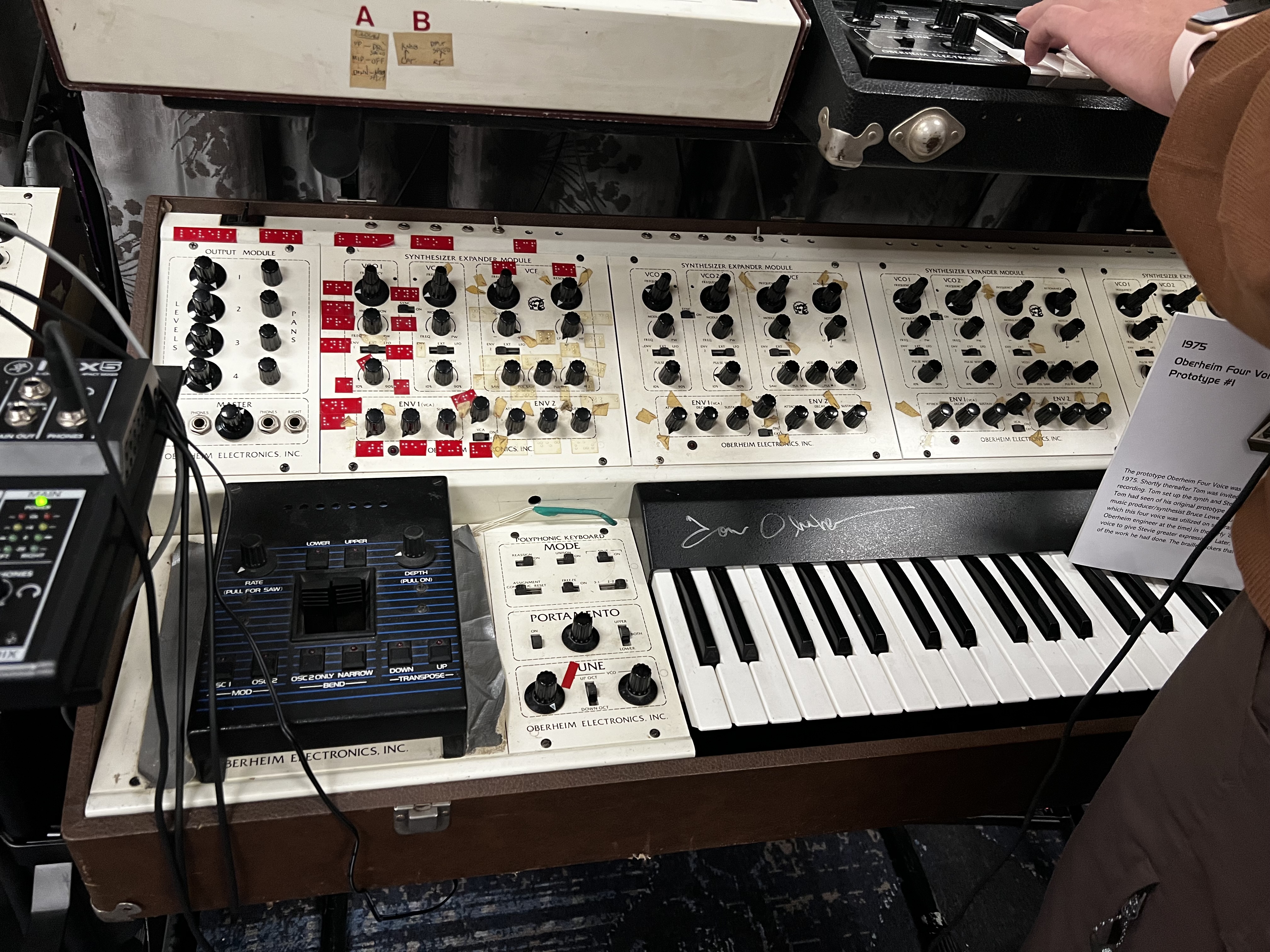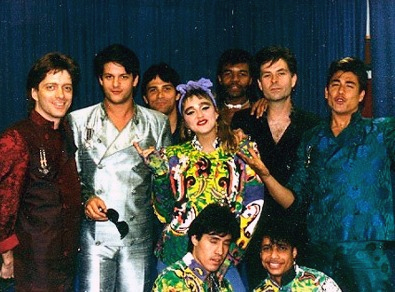|
OB-X
The Oberheim OB-X was the first of Oberheim's OB-series polyphonic analog subtractive synthesizers. First commercially available in June 1979, the OB-X was introduced to compete with the Sequential Circuits Prophet-5, which had been successfully introduced the year before. About 800 units were produced before the OB-X was discontinued and replaced by the updated and streamlined OB-Xa in 1981. The OB line developed and evolved after that with the OB-8 before being replaced by the Matrix series. The OB-X was used in popular music by Rush (on '' Moving Pictures'' and ''Signals''), Nena, Styx member Dennis DeYoung (used frequently from late 1979 to 1984), Queen (on '' The Game'', their first synthesizer on an album), Madonna for her debut album, Prince, and Jean-Michel Jarre who used it for its "brass" sounds. Specification The OB-X was the first Oberheim synthesizer based on a single printed circuit board called a "voice card" (still using mostly discrete components) rather ... [...More Info...] [...Related Items...] OR: [Wikipedia] [Google] [Baidu] |
Oberheim OB-Xa
The Oberheim OB-Xa was the second of Oberheim's OB-series polyphonic analog subtractive synthesizers, replacing the OB-X with updated features. History The OB-Xa was released in December 1980, replacing the OB-X after only a year on the market. The OB-Xa was the first Oberheim product adorned with blue horizontal pinstripes on black background that would become standard trade dress for future Oberheim products. While the OB-Xa offered the same polyphony as its predecessor (4, 6 and 8-voice models were offered), its keyboard could be split into two halves (each with its own voice) or to layer voices to create thicker sound (essentially making two notes sound for every key pressed). The OB-Xa also added the ability to switch between 2-pole 12 dB and 4-pole 24 dB filtering. It offered Filter Envelope modulation for oscillator 2 (which allows the pitch to be modulated by the envelope) in place of the OB-X's ability to cross modulate (frequency modulation of the first VCO ... [...More Info...] [...Related Items...] OR: [Wikipedia] [Google] [Baidu] |
Oberheim
Oberheim is an American synthesizer manufacturer founded in 1969 by Tom Oberheim. Beginning in 1975, Oberheim developed some of the first commercially available polyphonic synthesizers and was a prominent synthesizer and drum machine manufacturer through the mid-1980s. In 1988, the company changed ownership and was eventually purchased by Gibson Guitar Corporation, which developed new Oberheim products and licensed the trademark to other companies that produced Oberheim products, but development of Oberheim products ceased after 2000. In 2009, Tom Oberheim began developing instruments through his own company, and in 2019, Gibson returned the Oberheim trademark to Tom Oberheim, whose company rebranded as Oberheim. History and products Beginnings and first polyphonic synthesizers Tom Oberheim founded the company in 1969, originally as a designer and contract manufacturer of electronic effects devices for Chicago Musical Instruments under their Maestro brand, including the PS-1A ... [...More Info...] [...Related Items...] OR: [Wikipedia] [Google] [Baidu] |
Oberheim OB-X Internals
Oberheim is an American synthesizer manufacturer founded in 1969 by Tom Oberheim. Beginning in 1975, Oberheim developed some of the first commercially available polyphonic synthesizers and was a prominent synthesizer and drum machine manufacturer through the mid-1980s. In 1988, the company changed ownership and was eventually purchased by Gibson Guitar Corporation, which developed new Oberheim products and licensed the trademark to other companies that produced Oberheim products, but development of Oberheim products ceased after 2000. In 2009, Tom Oberheim began developing instruments through his own company, and in 2019, Gibson returned the Oberheim trademark to Tom Oberheim, whose company rebranded as Oberheim. History and products Beginnings and first polyphonic synthesizers Tom Oberheim founded the company in 1969, originally as a designer and contract manufacturer of electronic effects devices for Chicago Musical Instruments under their Maestro brand, including the PS-1A Ph ... [...More Info...] [...Related Items...] OR: [Wikipedia] [Google] [Baidu] |
Oberheim Electronics
Oberheim is an American synthesizer manufacturer founded in 1969 by Tom Oberheim. Beginning in 1975, Oberheim developed some of the first commercially available polyphonic synthesizers and was a prominent synthesizer and drum machine manufacturer through the mid-1980s. In 1988, the company changed ownership and was eventually purchased by Gibson Guitar Corporation, which developed new Oberheim products and licensed the trademark to other companies that produced Oberheim products, but development of Oberheim products ceased after 2000. In 2009, Tom Oberheim began developing instruments through his own company, and in 2019, Gibson returned the Oberheim trademark to Tom Oberheim, whose company rebranded as Oberheim. History and products Beginnings and first polyphonic synthesizers Tom Oberheim founded the company in 1969, originally as a designer and contract manufacturer of electronic effects devices for Chicago Musical Instruments under their Maestro brand, including the PS-1A ... [...More Info...] [...Related Items...] OR: [Wikipedia] [Google] [Baidu] |
Oberheim OB-8
The Oberheim OB-8 is a subtractive analog synthesizer launched by Oberheim in early 1983 and discontinued in 1985. As the fourth product in the OB-series of polyphonic compact synthesizers, the OB-8 was the successor to the OB-Xa. About 3,000 units were produced. Specification The OB-8 features eight-voice polyphony, two-part multi-timbrality, a 61-note processor-controlled piano keyboard, sophisticated programmable low-frequency oscillation (LFO) and envelope modulation, two-pole and four-pole filters, arpeggiator, external cassette storage, MIDI capability and 120 memory patches, 24 bi-timbral patches, and used the Z80 CPU. The musician's interface also consists of two pages of front panel programmable controls, left panel performance controls and a set of foot pedals and switches. Notable OB-8 users *Jack Antonoff *Art of Noise *Daft Punk *Jimmy Jam and Terry Lewis *Nik Kershaw *The KLF *Pet Shop Boys *The Police *Queen * Steve Roach *Simple Minds * Soul II Soul *Princ ... [...More Info...] [...Related Items...] OR: [Wikipedia] [Google] [Baidu] |
Oberheim Polyphonic
The Oberheim Polyphonic Synthesizer is a series of analog music synthesizers that was produced from 1975 to 1979 by Oberheim Electronics. Developed by Tom Oberheim, they were the first production synthesizers capable of playing chords. Background After Oberheim introduced the DS-2 digital music sequencer, Tom Oberheim recognized that customers wanted to play one synthesizer while the DS-2 played a sequence on another, or layer the sound of one synthesizer with another. To address this need, he introduced the Synthesizer Expander Module (SEM), a semi-modular analog synthesizer module, in 1974. The SEM featured two VCOs and a two-pole voltage-controlled filter that could operate as a low-pass, high-pass, band-pass, or band-reject filter, giving it a different sound than the Moog and ARP four-pole low-pass ladder filters popular at the time. Specification In late 1975, after Norlin canceled several large Maestro orders, Oberheim developed a series of polyphonic synthesizers b ... [...More Info...] [...Related Items...] OR: [Wikipedia] [Google] [Baidu] |
Madonna (Madonna Album)
''Madonna'' is the debut studio album by American singer Madonna, released on July 27, 1983, by Sire Records. In the late 1970s, Madonna had established herself as a singer in downtown New York City; alongside her Michigan boyfriend Stephen Bray, she put together a demo tape with four dance tracks and began pitching it around local nightclubs. She managed to get Mark Kamins, the resident DJ at Danceteria, to play " Everybody" —one of the songs from the tape. The song drew positive reception from the crowd, and Kamins took Madonna to Sire Records, where label president Seymour Stein signed her on for three twelve-inch singles. Following its release on October 6, 1982, "Everybody" found success on the dance scene, and the label approved the recording of an album. For the album, Madonna worked with Warner Bros. producer Reggie Lucas, who had worked with artists like Roberta Flack and Stephanie Mills. Soon, however, problems between the singer and Lucas arose, as she was not hap ... [...More Info...] [...Related Items...] OR: [Wikipedia] [Google] [Baidu] |
The Game (Queen Album)
''The Game'' is the eighth studio album by the British Rock music, rock band Queen (band), Queen. It was released on 30 June 1980 by EMI Records in the UK and by Elektra Records in the US. ''The Game'' features a different sound from its predecessor, ''Jazz (Queen album), Jazz'' (1978). ''The Game'' was the first Queen album to use a synthesizer (an Oberheim OB-X). A critical and commercial success, ''The Game'' became the only Queen album to reach No. 1 in the US, and also became their best-selling studio album in the US, with four million copies sold to date, tying with the sales for ''News of the World (album), News of the World''. Notable songs on the album include the bass-driven "Another One Bites the Dust" and the rock and roll "Crazy Little Thing Called Love", both of which reached No. 1 in the US. It was reissued in May 2003 on DVD-Audio with Dolby 5.1 surround sound and Digital Theater System, DTS 5.1. The 5.1 mix of "Coming Soon" features an alternate backing track, as ... [...More Info...] [...Related Items...] OR: [Wikipedia] [Google] [Baidu] |
Rush (band)
Rush was a Canadian rock music, rock band formed in Toronto in 1968 that consisted primarily of Geddy Lee (vocals, bass, keyboards), Alex Lifeson (guitars) and Neil Peart (drums, percussion). The band's original line-up consisted of Lifeson, drummer John Rutsey, and bassist and vocalist Jeff Jones (bassist), Jeff Jones, whom Lee immediately replaced. After Lee joined, the band went through a few line-up changes before arriving at its classic power trio line-up with the addition of Peart in July 1974, who replaced Rutsey four months after the release of their Rush (Rush album), self-titled debut album; this line-up remained unchanged for the remainder of the band's career. Rush first achieved moderate success with their second album, ''Fly by Night (album), Fly by Night'' (1975). The commercial failure of their next album ''Caress of Steel'', released seven months after ''Fly by Night'', resulted in the band nearly getting dropped from their then-record label Mercury Records. Rus ... [...More Info...] [...Related Items...] OR: [Wikipedia] [Google] [Baidu] |
Moving Pictures (Rush Album)
''Moving Pictures'' is the eighth studio album by Canadian rock band Rush, released on February 12, 1981, by Anthem Records. After touring to support their previous album, '' Permanent Waves'' (1980), the band started to write and record new material in August 1980 with longtime co-producer Terry Brown. They continued to write songs with a more radio-friendly sound, featuring tighter and shorter song structures compared to their earlier albums. ''Moving Pictures'' received a positive reception from contemporary and retrospective music critics and became an instant commercial success, reaching number one in Canada and number three in both the United States and the United Kingdom. It remains Rush's highest-selling album in the United States, with five million copies sold. "Limelight", " Tom Sawyer" and "Vital Signs" were released as singles across 1981, and the instrumental " YYZ" was nominated for a Grammy Award for Best Rock Instrumental Performance. Rush supported the album ... [...More Info...] [...Related Items...] OR: [Wikipedia] [Google] [Baidu] |
Synthesizers
A synthesizer (also synthesiser or synth) is an electronic musical instrument that generates audio signals. Synthesizers typically create sounds by generating waveforms through methods including subtractive synthesis, additive synthesis and frequency modulation synthesis. These sounds may be altered by components such as filters, which cut or boost frequencies; envelopes, which control articulation, or how notes begin and end; and low-frequency oscillators, which modulate parameters such as pitch, volume, or filter characteristics affecting timbre. Synthesizers are typically played with keyboards or controlled by sequencers, software or other instruments, and may be synchronized to other equipment via MIDI. Synthesizer-like instruments emerged in the United States in the mid-20th century with instruments such as the RCA Mark II, which was controlled with punch cards and used hundreds of vacuum tubes. The Moog synthesizer, developed by Robert Moog and first sold in 19 ... [...More Info...] [...Related Items...] OR: [Wikipedia] [Google] [Baidu] |





